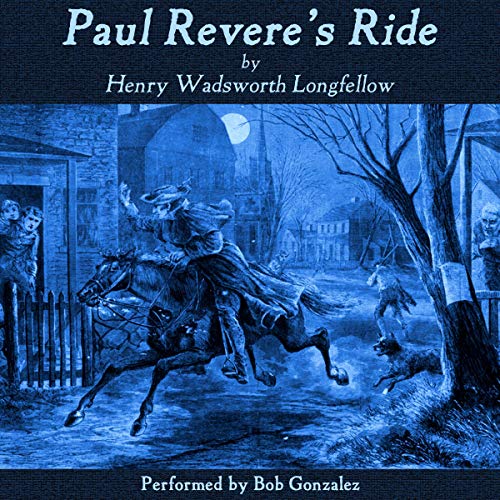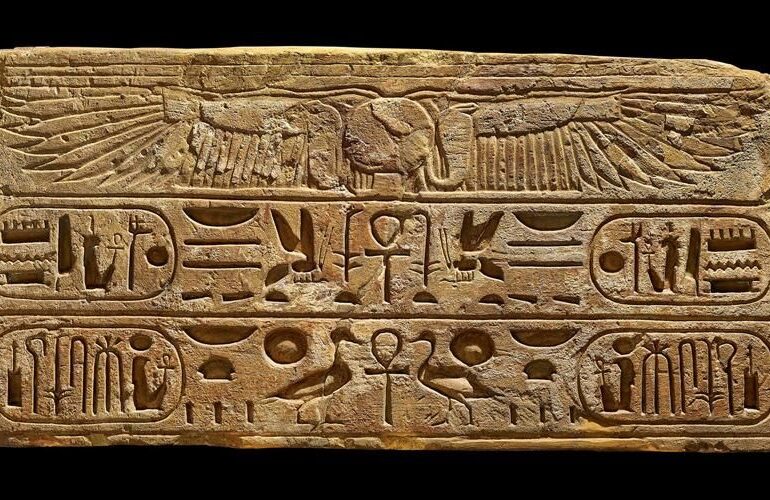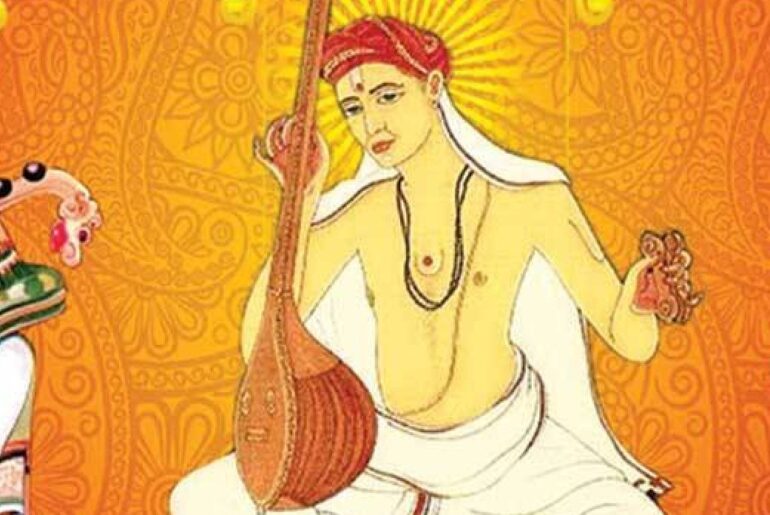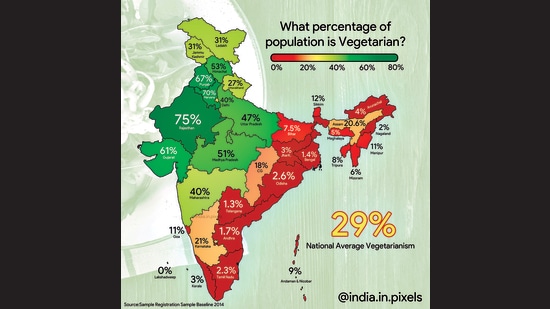Back in November 2007, Jeff Stiles, my new manager at SAP, invited me to talk about the role social networks play in marketing. Social media was still relatively new at that point in time and particularly relevant to the Small and Midsize Business Unit (which needed to reach millions of prospects) whose marketing we were just beginning to scale.
So, I pulled a deck together… and, in the best tradition of storytellers, used the history of the American freedom movement to tell the story.
I chanced upon this deck recently and chose to share a few snippets and the core storyline here. Enjoy!
The quick storyline:

- Loyalists spy on the British army (the Regulars) as they chat in Boston pubs.
- When it is clear that the Regulars are going to cross the Charles River and make a move, a signal goes up on the Old North Church. Triggering Paul Revere and William Dawes to skedaddle to Lexington, where Samuel Adams and John Hancock are holed up.
- Paul and William meet in Medford (Mystic, as it was then known as) and ride on to Lexington
- In the huddle with Adams and Hancock, they figure out that the British are headed to Concord, to raid an arms cache; not to Lexington, to get Adams and Hancock!
- So, Prescott joins the mad dash from Lexington to Concord
- But the 3 are stopped en route. In the mêlée, Prescott and Dawes take off. Revere is caught
- Revere tells the British patrol that the entire country side knows that they are coming and all is lost for them. So, the patrol lets him go and makes a dash for Boston, to warn the army marching up
- The Regular make their way up to Boston, firing as the advance. But, facing the armed villagers, flee to avoid being massacred. The American Revolution is launched. Soon to be joined by the 2nd amendment!
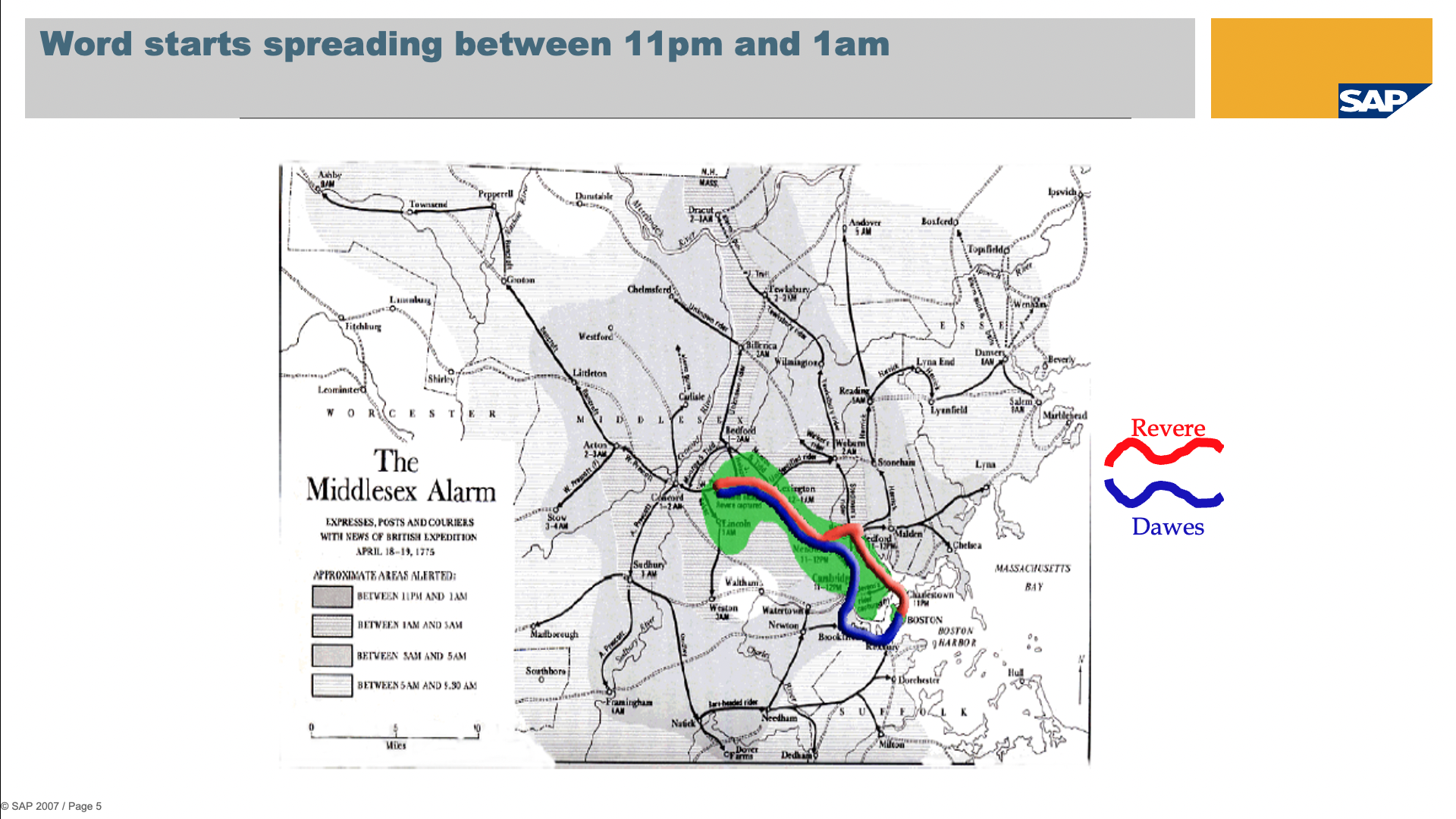
- Paul and Williams paths are shown in red and blue.
- The green overlay shows areas that have been warned thanks to their efforts.
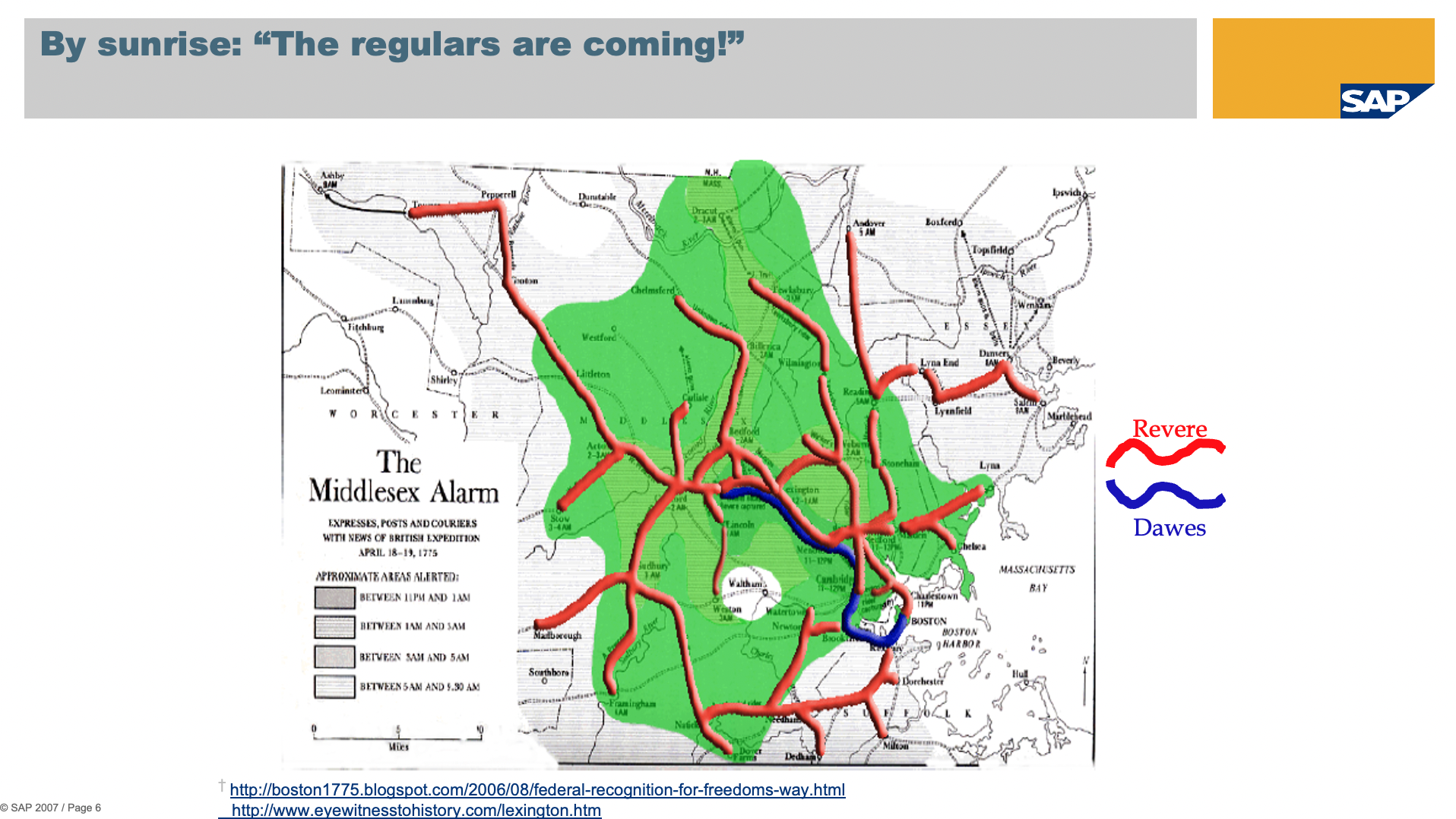
- Did you notice something interesting in the graphic above? Lots of red lines, almost no blue ones by sunrise!
- The answer to why this is the case lies in Paul’s social network — see next slide for details!
- An interesting observation: the village of Waltham appears to be a hole in this sea of green–presumably because of a lack of connectivity, word never gets to it even though it gets to everyone around it! They wake up to a totally new world…
- As this graphic shows, the southern towns aren’t well alerted and alerted in sufficient time. They, therefore, play a smaller role in the fight than the northern town that Paul alerted.

- Paul was already well connected
- Paul, apparently, stopped at many points along the way to speak to people whom he had long known. Trusting him, they in-turn, alerted others
- William wasn’t well known and apparently rode, heads down, to the Medford meeting point. With huge ramifications on information flow and war readiness.
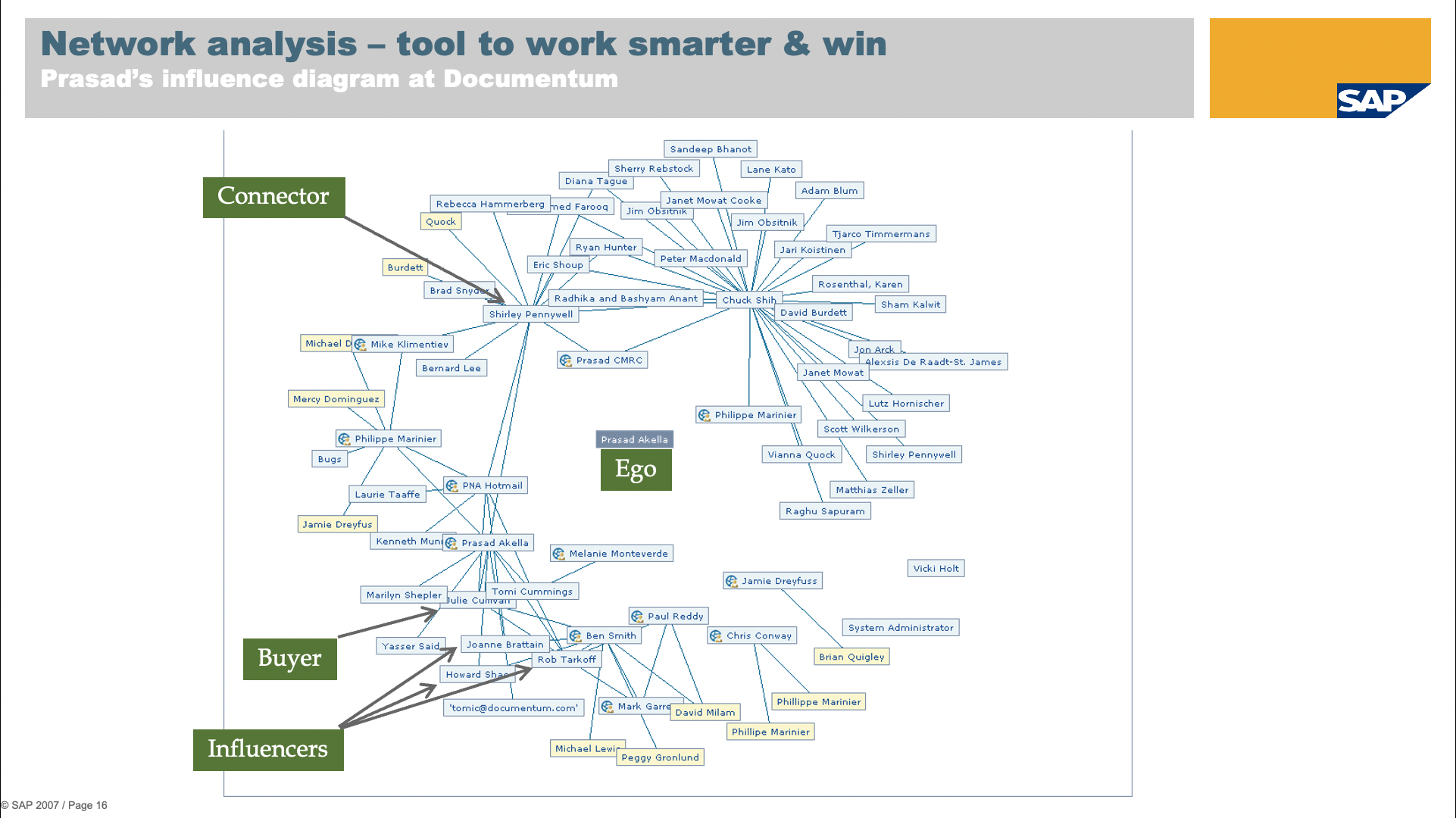
- While I haven’t looked at this space in 20+ years since Spoke, I can attest to the richness of social network analysis. When we started our work, no one had ever built a social graph with more than a thousand nodes. We had that on Day 1! Suddenly, and in a rather rare event, we left the academic world behind as we worked through scale, privacy, product, and value threads.
- The treatise by Wasserman and Wellman is THE place to start and end. My first 3 months at Spoke (including even before we were officially incorporated) were spend studying the space, since no one else on the team understood the required math, starting with linear algebra and graph theory.
- There are some very insightful case studies in the literature that help us understand how the theory can be applied in practice.
- The first is a case of a union attempting to unionize a firm that is documented in Nitin Nohira’s book on networks and organizations. The long and short of the story is that the union underestimates the role that a particular person, who had no formal title or senior role in the org, played in influencing the thinking of the voting group. And, loses the vote.
- Second, the Japanese business practice of “nemawashi” comes to mind. When distilled to its core, the idea is that you figure out, in advance, who are all the decision makers and, more importantly, the influencers, and engage them privately, before the public meeting. In so doing, you have had a chance to hear their feedback (good and bad) and address it before you walk into the formal meeting. No surprises ==> you get the desired outcome!
- Looking at the above, I have long felt that LinkedIn has underserved the market—there is so much in our social graphs that it just hasn’t made any attempt to mine and put to good use. I guess that success has curbed their appetite!
- It’s clear to me that despite the “rich node gets richer” behavior in these network centric markets, it might be time to take on the space once more since there are other large networks available to be tapped (e.g., WhatsApp, YouTube, GitHub, …). If a $27B exit is enticing, hit me up! Especially if you have access to a large, core social network’s data.
- Here’s Henry Longfellow’s poem describing Paul Revere’s ride
The Midnight Ride of Paul Revere By Henry Wadsworth Longfellow Listen my children and you shall hear Of the midnight ride of Paul Revere, On the eighteenth of April, in Seventy-five; Hardly a man is now alive Who remembers that famous day and year. He said to his friend, "If the British march By land or sea from the town to-night, Hang a lantern aloft in the belfry arch Of the North Church tower as a signal light,-- One if by land, and two if by sea; And I on the opposite shore will be, Ready to ride and spread the alarm Through every Middlesex village and farm, For the country folk to be up and to arm." Then he said "Good-night!" and with muffled oar Silently rowed to the Charlestown shore, Just as the moon rose over the bay, Where swinging wide at her moorings lay The Somerset, British man-of-war; A phantom ship, with each mast and spar Across the moon like a prison bar, And a huge black hulk, that was magnified By its own reflection in the tide. Meanwhile, his friend through alley and street Wanders and watches, with eager ears, Till in the silence around him he hears The muster of men at the barrack door, The sound of arms, and the tramp of feet, And the measured tread of the grenadiers, Marching down to their boats on the shore. Then he climbed the tower of the Old North Church, By the wooden stairs, with stealthy tread, To the belfry chamber overhead, And startled the pigeons from their perch On the sombre rafters, that round him made Masses and moving shapes of shade,-- By the trembling ladder, steep and tall, To the highest window in the wall, Where he paused to listen and look down A moment on the roofs of the town And the moonlight flowing over all. Beneath, in the churchyard, lay the dead, In their night encampment on the hill, Wrapped in silence so deep and still That he could hear, like a sentinel's tread, The watchful night-wind, as it went Creeping along from tent to tent, And seeming to whisper, "All is well!" A moment only he feels the spell Of the place and the hour, and the secret dread Of the lonely belfry and the dead; For suddenly all his thoughts are bent On a shadowy something far away, Where the river widens to meet the bay,-- A line of black that bends and floats On the rising tide like a bridge of boats. Meanwhile, impatient to mount and ride, Booted and spurred, with a heavy stride On the opposite shore walked Paul Revere. Now he patted his horse's side, Now he gazed at the landscape far and near, Then, impetuous, stamped the earth, And turned and tightened his saddle girth; But mostly he watched with eager search The belfry tower of the Old North Church, As it rose above the graves on the hill, Lonely and spectral and sombre and still. And lo! as he looks, on the belfry's height A glimmer, and then a gleam of light! He springs to the saddle, the bridle he turns, But lingers and gazes, till full on his sight A second lamp in the belfry burns. A hurry of hoofs in a village street, A shape in the moonlight, a bulk in the dark, And beneath, from the pebbles, in passing, a spark Struck out by a steed flying fearless and fleet; That was all! And yet, through the gloom and the light, The fate of a nation was riding that night; And the spark struck out by that steed, in his flight, Kindled the land into flame with its heat. He has left the village and mounted the steep, And beneath him, tranquil and broad and deep, Is the Mystic, meeting the ocean tides; And under the alders that skirt its edge, Now soft on the sand, now loud on the ledge, Is heard the tramp of his steed as he rides. It was twelve by the village clock When he crossed the bridge into Medford town. He heard the crowing of the cock, And the barking of the farmer's dog, And felt the damp of the river fog, That rises after the sun goes down. It was one by the village clock, When he galloped into Lexington. He saw the gilded weathercock Swim in the moonlight as he passed, And the meeting-house windows, black and bare, Gaze at him with a spectral glare, As if they already stood aghast At the bloody work they would look upon. It was two by the village clock, When he came to the bridge in Concord town. He heard the bleating of the flock, And the twitter of birds among the trees, And felt the breath of the morning breeze Blowing over the meadow brown. And one was safe and asleep in his bed Who at the bridge would be first to fall, Who that day would be lying dead, Pierced by a British musket ball. You know the rest. In the books you have read How the British Regulars fired and fled,--- How the farmers gave them ball for ball, From behind each fence and farmyard wall, Chasing the redcoats down the lane, Then crossing the fields to emerge again Under the trees at the turn of the road, And only pausing to fire and load. So through the night rode Paul Revere; And so through the night went his cry of alarm To every Middlesex village and farm,--- A cry of defiance, and not of fear, A voice in the darkness, a knock at the door, And a word that shall echo for evermore! For, borne on the night-wind of the Past, Through all our history, to the last, In the hour of darkness and peril and need, The people will waken and listen to hear The hurrying hoof-beats of that steed, And the midnight message of Paul Revere.
This deck and article stand on the shoulders of others who did the underlying homework. I cited them in the original deck. But, as I look around now, some 15+ years later, I cannot always find the sources I cited in the deck (e.g., where I got the graphics from). Many of the links are, not surprisingly, non-functional! My apologies for this and my sincere thanks to the original artists and authors! Please ping me if you have any info on them, as I will absolutely give credit where due.

